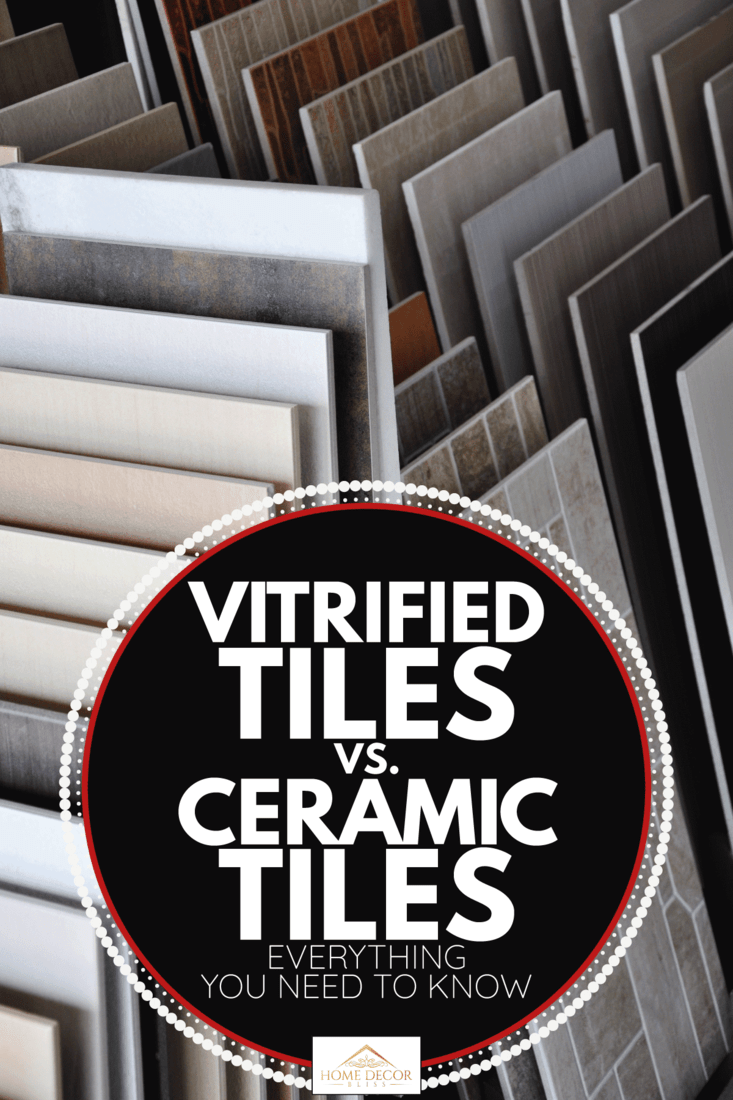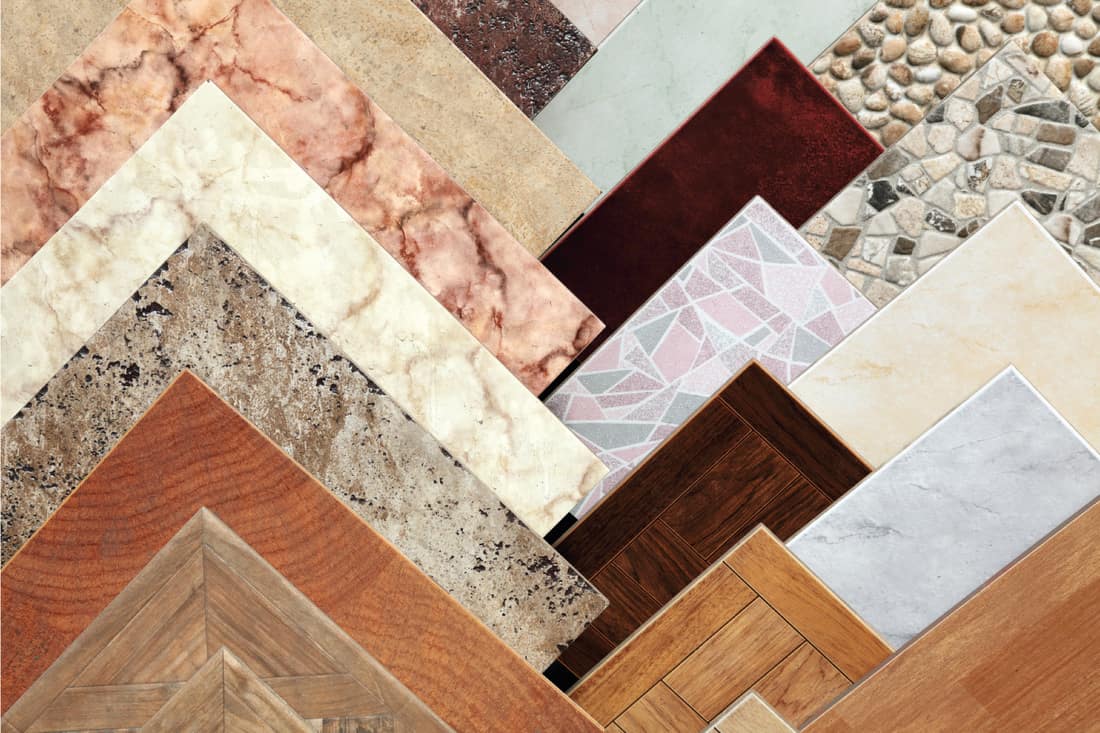If you are planning to put some tile flooring down in your home, then you've probably come across various types of tile. Two of these types, vitrified and ceramic tiles, can seem the same, but they have some important differences. We have gladly researched both types and will explain the differences and the similarities between them here.
Ceramic tile and vitrified tiles are made through superheating earthen mixtures, but vitrified tiles contain more diverse minerals. Although comparable, vitrified tile is the better all-around tile in terms of durability and range of uses. Ceramic tile is a less expensive option that is still good for indoor use, particularly in low-moisture areas.
- Vitrified tile has a glossy appearance and is durable, scratch-resistant, water-resistant and, UV light-resistant, but it is the more expensive option.
- Ceramic tile is less resistant to the elements but has a natural look and is better for lower-budget projects.
That's the tip of the iceberg for comparing these two types of tile. Each material's pros and cons have a few caveats, and proper care is often more important than material choice. To find out more about vitrified and ceramic tiles, please continue reading.

Differences and Similarities Between Vitrified and Ceramic Tiles
Vitrified and ceramic tiles are two of the most common materials used in flooring and kitchen and bathroom walls. Although their uses are the same, the look and feel of the two types of materials are quite different. These differences come from the raw materials that go into making each tile type.
How are vitrified and ceramic tiles made?
The main raw material that makes both types of tile is clay, a type of soil that hardens when baked at high temperatures. Clay is naturally occurring but can also be created artificially. The difference between the two tile types comes from the composition of that clay-based mixture.
While ceramic tiles contain only the clay mixture, the vitrified tile contains more than just regular clay. Vitrified tiles contain the clay mixture plus other minerals like quartz, silica, and feldspar. These mineral differences change the nature and texture of the finished tiles.
To create the final product, manufacturers form this mixture into the recognizable shape of flooring tiles and paint with a protective coating or color them if necessary. After that, the tiles bake in a large kiln under steady heat for up to 14 hours. This heating process, called firing, is used for pottery as well.
What are the texture differences between vitrified and ceramic tiles?
Although they are relatively similar in their material components, the two tiles look different and feel different to the touch. Vitrified tile has a very smooth finish thanks to the added minerals, but ceramic tiles have a natural appearance and feel slightly rough to the touch, much more like natural stone.

We may include affiliate links and curated AI content to highlight top design styles.
Are vitrified tiles slippery?
Vitrified tiles have a very sleek, smooth and, glossy finish. This finish and the material components of the tile make it resistant to water absorption. Because of this, liquid can collect and remain on top of the vitrified tile, making the surface incredibly slippery. By nature, they are easier to clean because of this.
Fortunately, vitrified tiles are available with non-slip finishes, which will keep you and your family from slipping every time there is a spill. On the other hand, Ceramic tile is not slippery by nature due to its more rough and porous texture.
Are vitrified tiles more durable than ceramic tiles?
As mentioned above, vitrified tiles have extra minerals in the clay mixture that creates them. Due to the combination of minerals, vitrified tiles are also less likely to break than ceramic tiles, which are more easily scratched or otherwise damaged. Ceramic tiles are also at risk for staining and discoloration caused by direct exposure to ultraviolet light.
What is the cost difference between vitrified and ceramic tiles?
Ceramic tiles are a cheaper alternative to vitrified tiles. The amount and variety of minerals it takes to produce vitrified tiles causes the production process to be more expensive than the ceramic tiles. If the price point is a major factor in your decision-making between the two tile types, ceramic tile will always be less expensive.
For example, ceramic tile costs between $1-4 on average, depending on thickness and quality. Vitrified tile, on the other hand, often costs double or triple that price.
Where to use vitrified tile?
Due to the water-resistance of vitrified tiles, it is perfect for both indoor and outdoor uses. Indoor areas that experience a lot of spilled liquid, like kitchens or bathrooms, can be the perfect places for vitrified tiles as they are easy to clean in the event of a spill or leak. You can even tile your entire home with vitrified tile. The glossy finish and durability will stand the test of time in any room of your house.
Where to use ceramic tiles?
It is not a good idea to use ceramic tile as outdoor tile. Ceramic tiles are more porous than vitrified tiles, causing them to be more susceptible to water damage. This can become an issue in cold environments where water can seep into cracks in the tile, freeze, and cause physical damage.
Ceramic tile is best in areas that won't be exposed to much moisture, like living rooms, dining rooms, or hallways. Some ceramic tiles have a special layer to help prevent water damage. These types of tiles are also great for bathrooms and kitchens.
Caring for your tile
After choosing the right tile and installing it, you will want to keep it in the best possible condition. Doing so will make your home bright and feeling clean for years to come. The first step in doing so is ensuring you choose the right tile for the environment and use, as mentioned above. The next step is repetitive cleaning and care for your specific type of tile.
How to clean vitrified floor tiles
As mentioned earlier, the non-porous qualities of vitrified tiles make them more water-resistant, and therefore more easily cleaned. Always avoid using corrosive cleaning solutions that include ingredients like bleach. A cleaning solution that is easy on the floor and cleans well can be made from a combination of water and vinegar.
Use a soft or microfiber-based mop, like the one pictured below, to clean vitrified floor tiles. This type of cleaning tool will pick up dirt and grime instead of just spreading it across the tile surface and into the grout between the tiles, however small they may be. If the tile you need to clean is located on a wall or backsplash, use the same mixture with a microfiber cloth.
Click here to see the Starbright Super Absorbant Mop at Amazon.
What is the best way to clean ceramic tiles?
If you have a regular or glazed ceramic tile floor, clean your tile just as if it was vitrified, using a soft mop and gentle cleaning solution consisting of water mixed with vinegar.
Ceramic tiles typically have more pronounced and visible grout lines between them that can turn dark over time due to dirt build-up. You can clean grout by mixing water with hydrogen peroxide and then scrubbing the solution on the grout with a toothbrush.
In Closing
So, is vitrified tile or ceramic tile the superior flooring material? Both have their advantages. Ceramic tile is affordable and vitrified tile is more durable. Vitrified tile is safe for use outdoors, while ceramic tile should be reserved for indoor use. Whichever is best for your space, we hope that you can now make a confident tile choice and then care for your tile for years to come.
While you're here, please check out our other posts on tile flooring:




